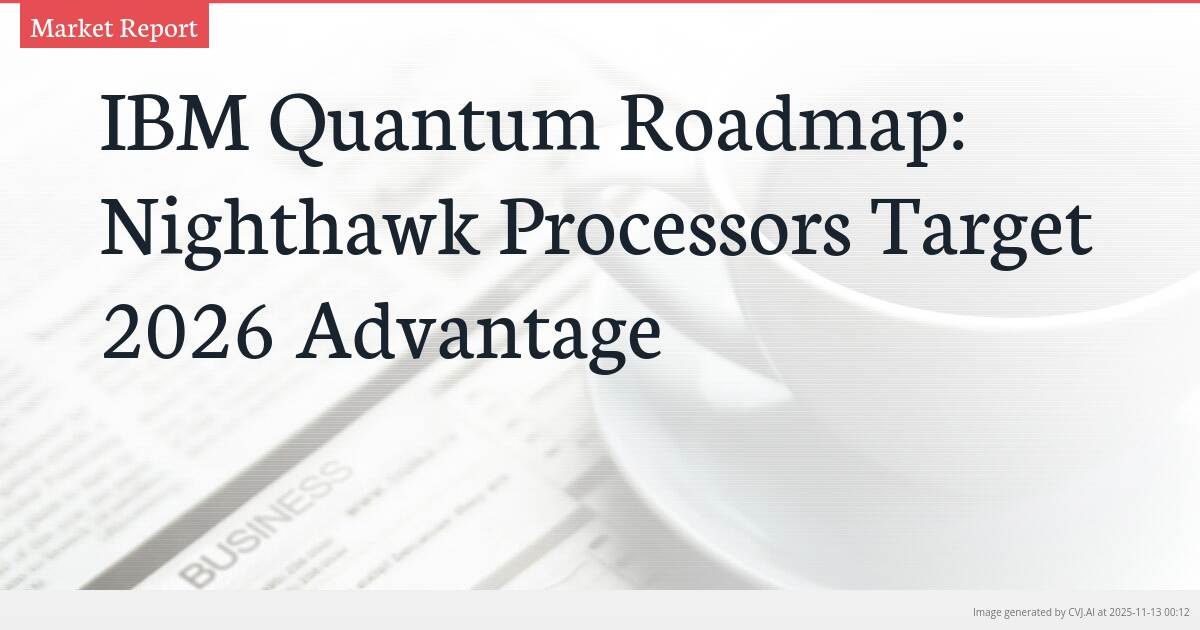This summary text is fully AI-generated and may therefore contain errors or be incomplete.
Introduction
IBM has launched its next-generation Nighthawk and Loon quantum processors, marking a significant acceleration in the race toward practical quantum computing. With the 120-qubit Nighthawk processor enabling circuits supporting up to 5,000 two-qubit gates, IBM aims to achieve community-verified quantum advantage by 2026 and critical fault tolerance milestones by 2029. While these developments represent IBM’s most aggressive push yet toward scalable quantum systems, current technology remains far from threatening Bitcoin’s encryption, which would require millions of physical qubits.
Key Points
- Nighthawk processor features 120 qubits with 218 couplers, enabling 5,000 two-qubit gate circuits and 30% greater complexity than previous IBM designs
- IBM's manufacturing transition to 300mm wafers has doubled research speed and increased chip complexity tenfold while enabling parallel processor development
- The company's quantum advantage tracker platform partners with Algorithmiq and Flatiron Institute to benchmark quantum vs classical computing performance
Nighthawk Processor: A Quantum Leap Forward
The IBM Nighthawk processor represents a substantial advancement in quantum computing hardware with its 120 qubits and 218 tunable couplers, approximately 20% more than IBM’s previous Heron design from 2023. This enhanced architecture supports circuits roughly 30% more complex than previous generations, enabling computations of up to 5,000 two-qubit gates while maintaining low error rates. The first Nighthawk systems are expected to reach users by the end of 2025, with future iterations projected to exceed 1,000 connected qubits by 2028, positioning the technology as a crucial step toward commercially viable quantum computing by the end of the decade.
According to IBM Research Director Jay Gambetta, “We believe that IBM is the only company that is positioned to rapidly invent and scale quantum software, hardware, fabrication, and error correction to unlock transformative applications.” This confidence stems from significant manufacturing improvements, including the transition to 300-millimeter wafer production at the Albany NanoTech Complex in New York. IBM reports this move has doubled research speed, increased chip complexity tenfold, and enabled multiple processor designs to be developed and explored in parallel.
The Road to Quantum Advantage and Fault Tolerance
IBM’s announcement positions the United States-based company to achieve what it calls “community-verified quantum advantage” by 2026—the point at which a quantum computer performs a task that no traditional computer can match. The Nighthawk processor serves as the next waypoint in IBM’s Starling roadmap, a comprehensive strategy announced in July to deliver a large-scale, fault-tolerant quantum computer—IBM Quantum Starling—by 2029. Fault tolerance, the ability of a quantum computer to maintain stable performance despite errors, represents the holy grail for practical quantum computing applications.
Complementing the Nighthawk, IBM’s experimental Quantum Loon processor demonstrates all key hardware components needed for fault-tolerant quantum computing. The company reported a tenfold speedup in error-decoding performance, achieving real-time correction under 480 nanoseconds using qLDPC codes—a milestone IBM said came a year ahead of schedule. The Loon architecture builds on technologies proven in other test systems, including long-range “c-couplers” that link distant qubits and the ability to reset qubits between operations.
IBM’s progress follows Google’s recent announcement that its Willow processor achieved a verified quantum speed-up, completing a physics simulation faster than any known classical supercomputer. This competitive landscape has accelerated investment in quantum computing research and development across the industry.
Bitcoin Security and Quantum Computing Realities
While IBM’s quantum advancements bring the industry closer to what some call “Q-Day,” the new processors remain far from posing an immediate threat to Bitcoin’s elliptic curve cryptography. Cracking BTC’s encryption would require a fault-tolerant quantum computer with roughly 2,000 logical qubits, which translates to tens of millions of physical qubits once error correction is factored in. The current 120-qubit Nighthawk processor, while impressive, represents only a fraction of the computational power needed to challenge cryptocurrency security.
The renewed focus on quantum computing has nonetheless sparked concerns about the long-term security of digital assets denominated in USD and other currencies. IBM’s partnership with Algorithmiq, the Flatiron Institute, and BlueQubit to launch a quantum-advantage tracker provides an open-source platform for comparing quantum and classical results across benchmark experiments, helping the scientific community better understand the evolving capabilities and limitations of quantum technology.
Software and Ecosystem Development
IBM is expanding its Qiskit software ecosystem to match the new hardware capabilities. The company reports that dynamic circuits in Qiskit improved accuracy by 24% at the 100-qubit scale, while a new C-API interface links Qiskit with high-performance classical systems to accelerate error mitigation. IBM claims this reduces the cost of extracting accurate results by more than 100 times, making quantum computations more accessible and practical for research applications.
Looking ahead to 2027, IBM plans to add computational libraries for machine learning and optimization to help researchers model physical and chemical systems. These software advancements, combined with the hardware roadmap, create a comprehensive approach to quantum computing development that addresses both the computational power and the practical usability required for real-world applications.
📎 Read the original article on decrypt.co

